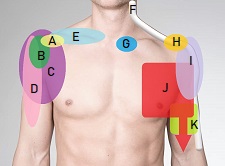- Home
- Diagnosis Guide
- Lump On Arm
- Collarbone Lumps
Lump On Collarbone
Written By: Chloe Wilson BSc (Hons) Physiotherapy
Reviewed By: SPE Medical Review Board
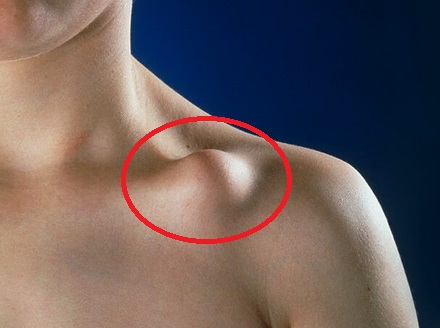
A lump on the collarbone is a common problem that can be caused by a number of things.
The collarbone, aka clavicle, is a long bone that runs along the top of the shoulder and upper chest between the sternum (breastbone) and the shoulder joint.
The collarbone plays a crucial role in the structure and function of the shoulder joint, providing mobility and stability for everyday activities and arm movements.
Collarbone lumps are usually caused by injuries, infections or excess fluid, but occasionally there may be something serious going on.
The clavicle sits just underneath the skin so any abnormalities to the bone or surrounding tissues are usually easy to see and feel.
Here we will look at both the common and rarer causes of bumps and lumps on the collarbone, the causes and symptoms of each, how to tell which you have and the best ways to treat clavicle lumps.
What Causes A Collarbone Lump?
A lump on the collarbone is usually due to a problem in the:
- Bones/Joints: e.g. clavicle fracture or ACJ dislocation
- Soft Tissues: e.g. excess fluid, inflammation or irritation
We’ll start by looking at the five most common causes of a lump on the clavicle, what causes them and the common symptoms associated with each to help you work out what is causing your collarbone lump, and then we’ll look at the best treatment options.
1. Collarbone Fractures
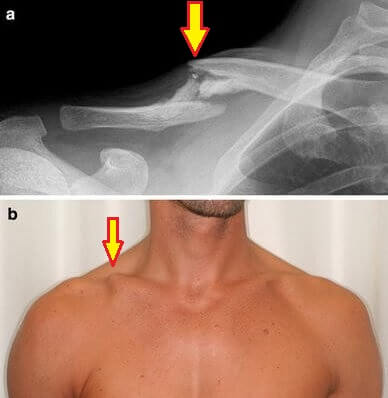
The most common cause of a hard lump on the collarbone is a clavicle fracture.
A clavicle fracture is where there is a break in the collarbone. There may be a small hairline fracture, a complex fracture with multiple breaks or anything in between.
Collarbone fractures are a common shoulder injury, usually caused by trauma such as a:
- Fall: either sideways onto the outer shoulder or falling onto an outstretched arm
- Direct Blow: to the collarbone e.g. contact sports and winter sports
- Road Traffic Accident: car, motorbike or push bike collisions
Common symptoms of collarbone fractures include:
- Collarbone Pain: Immediate sharp pain at the time of injury with ongoing dull aching pain that gets with arm movements
- Deformity: A broken collarbone lump may be small and soft if the fracture is minor and undisplaced. With more severe breaks, part of the clavicle bone may have been pushed out of position leading to a hard bump with an obvious deformity. With more serious open fractures, the clavicle may even protrude through the skin.
- Snapping/Grinding: strange noises and sensations may occur when you move the arm
In the longer term, you may end up with a small, permanent hard lump on the collarbone following a clavicle fracture. As the broken bone heals, the body lays down extra bone to knit the bones back together and in some cases, excess bone can form around the fracture site known as bone spurs or osteophytes. These hard lumps on the clavicle don’t usually cause any problems unless the break was close to the joint in which case it may slightly reduce shoulder range of motion.
You can find out more about the causes, symptoms, diagnosis and treatment options in the Clavicle Fractures section.
2. Enlarged Lymph Nodes
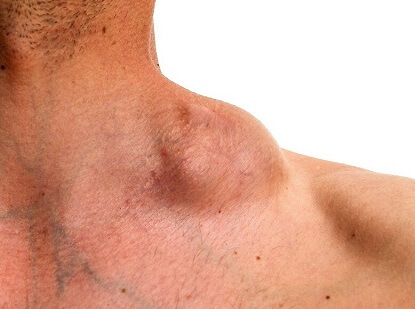
Another common cause of lumps on or near the collarbone are enlarged lymph nodes.
There are hundreds of lymph nodes, aka lymph glands, located all around the body.
Lymph nodes are part of the body’s immune system and are joined together by a network of channels that carry lymph fluid around the body.
The lymphatic system contains white blood cells, known as lymphocytes, and antibodies that help our bodies to fight infections.
There is a collection of lymph glands just above the clavicle known as the supraclavicular lymph nodes. They are usually pea-sized but can quickly swell and become painful when the body is fighting off an infection, forming a lump above the collarbone that may be marble sized or larger. Bacterial or viral infections such as throat infections, the common cold, influenza or chickenpox can all cause the lymph nodes to swell forming a lump on the clavicle as the immune system fights off the infection.
A lump on the collarbone from enlarged lymph nodes usually settles down within a couple of weeks. In most cases, enlarged lymph nodes aren’t a cause for concern but if they don’t settle down within 2 weeks or they are swollen without any other signs of infection, get checked out by your primary care doctor as soon as possible.
3. Shoulder Cysts
A soft, mobile lump on the collarbone is often due to a cyst. Shoulder cysts develop when excess fluid collects and forms a small sac or pocket. They typically develop in response to a shoulder injury, degeneration, infection or underlying medical issue.
There are a number of different types of shoulder cysts that can cause a lump on the collarbone, the most common being:
- Ganglion Cysts: form just under the skin near joints or tendons and are filled with thick, jelly-like fluid. A ganglion cyst lump on collarbone may range in size from 0.5-4cm
- Subcortical Cysts: form just underneath the outer layer of bone. These shoulder cysts are usually associated with impingement syndrome, rotator cuff tears or aging
- Epidermoid Cyst: aka sebaceous cysts are small sacs filled with keratin (one of the proteins found in skin cells) that can form a lump on collarbone
In most cases a lump on the clavicle from a shoulder cyst is completely harmless and may not cause any problems at all.
You can find out more about the different types of cysts that can cause a lump on the collarbone including the common causes, symptoms, diagnosis and treatment in the Shoulder Cysts section.
4. Lipoma

Another possible cause of a lump on the collarbone is a lipoma, a benign (non-cancerous) fat-filled lump.
Lipoma lumps on the clavicle tend to be slow-growing, painless and mobile. The lump typically feels rubbery and soft and they tend to be round or oval-shaped and less than 5cm in diameter.
Lipomas are fairly common, affecting around 1% of the population. They are most common between the ages of 40-60 but can occur at any age. The underlying cause is unknown but there is thought to be a genetic link meaning you are more likely to get lipomas if other members of your family do.
In most cases, a lipoma lump on the collarbone won’t require any treatment unless it starts encroaching on other structures and causing symptoms.
5. ACJ Injuries
A lump at the outer edge of the collarbone may indicate a problem at the acromioclavicular joint – the joint between the collarbone and the shoulder, such as:
- ACJ Dislocation: where the collarbone gets forced upwards, stretching or tearing the ligaments so the clavicle sticks up slightly at the joint. The further out of position the clavicle is forced, the greater the prominence and size of the collarbone lump
- ACJ Inflammation: swelling around the acromioclavicular joint can develop if the joint is irritated from overuse or repetitive strain. ACJ inflammation may result in a soft, palpable lump on the collarbone, directly over the joint
- ACJ Arthritis: joint inflammation and bone spurs can develop with ACJ arthritis resulting in a hard lump over the joint
Treatment for a lump on the collarbone from an ACJ problem will depend on the underlying cause but will usually involve a combination of rest, rehab exercises, medication, joint injection or occasionally, surgery.
Rare Causes Of Lump On Clavicle
There are a number of other possible causes of a lump on the collarbone but they tend to be less common.
1. Bone Infection
Occasionally, a lump on the collarbone may be due to a bone infection, typically osteomyelitis.
Osteomyelitis usually occurs after a shoulder injury, shoulder surgery or following an intravenous line placement near the collarbone if you’ve had an IV in-situ.
Common symptoms of osteomyelitis include swelling or a lump on the collarbone, localised pain, fever, feeling unwell, sweating and reduced shoulder movements.
A collarbone lump from osteomyelitis is treated with a course of intravenous antibiotics, usually lasting around 4-6 weeks. Prompt treatment is vital so see your doctor as soon as possible if you suspect the lump on your collarbone is osteomyelitis.
2. Shoulder Bursitis
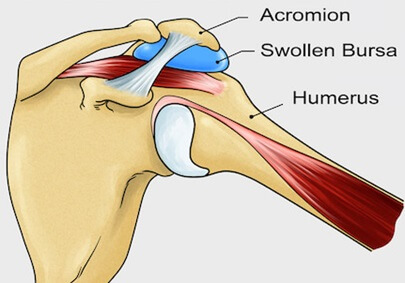
Shoulder bursitis can cause a lump around the collarbone.
Bursa are small fluid-filled sacs found all around the body that sit between soft tissues and bones to reduce friction. When they get irritated, they swelling, forming soft lumps.
There are a number of bursa located around the shoulder but the ones most likely to cause a lump on the clavicle are subacromial bursitis and supra-acromial bursitis, both found towards the outer edge of the collarbone.
Bursitis is usually caused by repetitive friction, particularly during overhead activities e.g. racket sports or manual labour. Shoulder bursitis symptoms usually include a soft, defined lump on the clavicle, pain when moving the arm, shoulder weakness and stiffness.
You can find out all about the different types of bursitis lumps on the clavicle and the causes, symptoms, diagnosis and treatment of each in the Shoulder Bursitis section.
3. Lymphoma
Occasionally, people can develop a lymphoma collarbone lump. Lymphoma is a rare but serious condition.
Lymphoma is a type of blood cancer that affects the body’s white blood cells (lymphocytes) and immune system. Common symptoms include a lymphoma collarbone lump which is usually painless, unexplained weight-loss, night sweats, fatigue and fever. If the lump on your collarbone is associated with these symptoms, see your doctor as soon as possible.
Diagnosing Collarbone Lumps
If you develop a lump on your collarbone it is important to get it looked at by your doctor to ensure an accurate diagnosis.
You doctor will start by talking to you about your symptoms, medical history and normal daily activities. They will then examine your shoulder looking at arm movements, muscle strength and will assess the collarbone position. They may then send you for further investigations such as x-rays, CT or MRI scan, ultrasound or biopsy to confirm what is causing the collarbone lump.
Differential Diagnosis
A hard lump on the collarbone usually indicates a bone problem such as a clavicle fracture, ACJ dislocation or bone spurs.
A soft clavicle lump may be a shoulder cyst, enlarged lymph node, lipoma, or bursitis.
A painful lump on the collarbone that hurts when you press on it is usually due to a fracture, ACJ injury, shoulder bursitis or on rare occasions, osteomyelitis.
A painless lump on the clavicle may be a shoulder cyst, lipoma or occasionally lymphoma.
A broken collarbone bump is usually associated with either a contact injury or a fall and causes immediate localised pain. Shoulder movement is usually limited and there may be an obvious deformity.
A lymphoma collarbone lump is extremely rare and is usually accompanied by other symptoms such as a fever, night sweats and unexplained weight-loss.
Lump On Collarbone Summary
There are lots of possible causes of a lump on the collarbone, most of which are nothing serious.
The most common causes of a lump on the clavicle are fractures, ACJ injuries, shoulder cysts, enlarged lymph nodes and lipomas.
In most cases a lump on the collarbone is nothing to worry about but occasionally it may be a sign of a serious condition such as lymphoma or osteomyelitis. Any new collarbone lump should be reviewed by your doctor.
Lumps and bumps can develop anywhere around the shoulder. If none of these is sounding like the cause of your clavicle lump, check out the shoulder lumps section. And if you are more bothered by pain than a lump on your clavicle, checkout the collarbone pain diagnosis section.
You may also be interested in the following articles:
- Shoulder Pain Diagnosis Charts
- Lump On Top Of Shoulder
- Lump On Back Of Shoulder
- Shoulder Pain At Night
- Shoulder Blade Pain
- Elbow Lumps & Bumps
- Common Shoulder Injuries
Related Articles
Upper Arm Pain
September 23, 2023
Diagnosis Charts
September 28, 2023
Rehab Exercises
December 12, 2023
Medical & Scientific References
- Journal Of Bone Oncology: Bone Tumors Of The Clavicle
- Radiopaedia: Clavicle Tumors
- National Library Of Medicine: Clavicle Fractures
- Wikipedia: Supraclavicular Lymph Nodes
Page Last Updated: May 1st, 2024
Next Review Due: May 1, 2026

